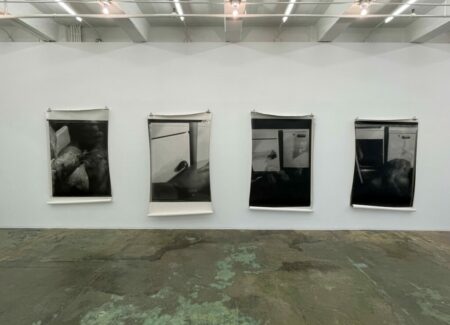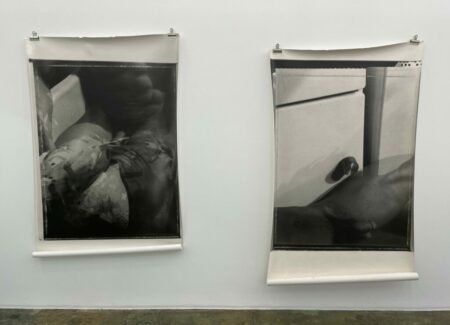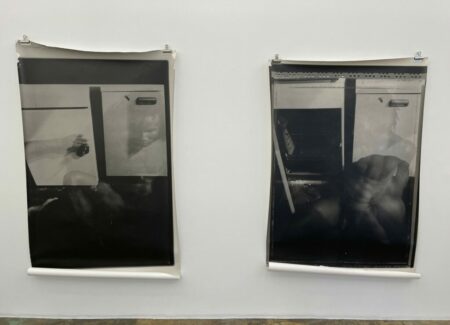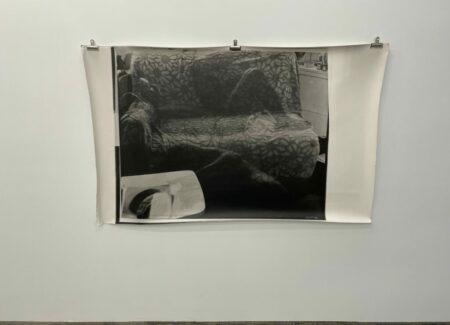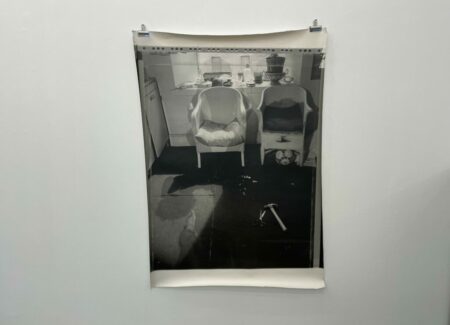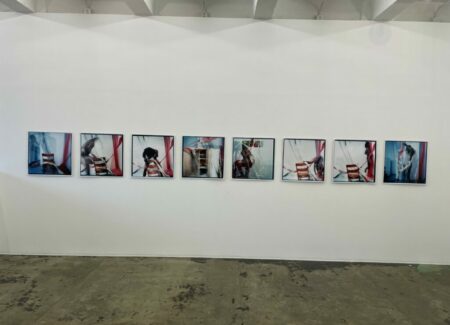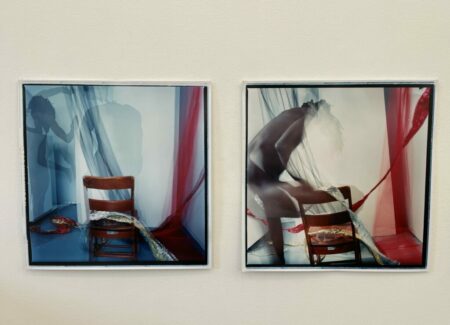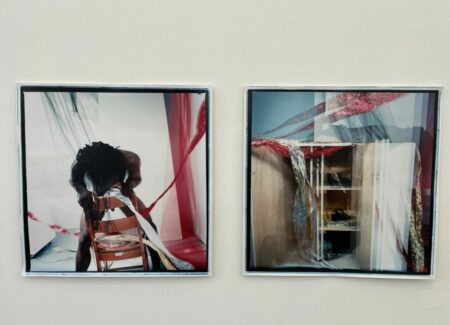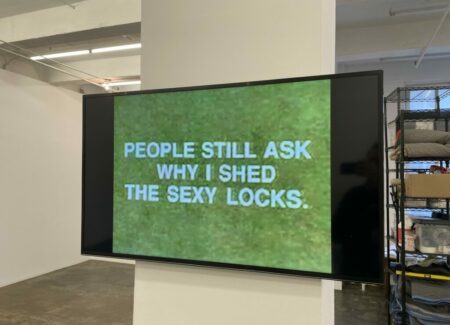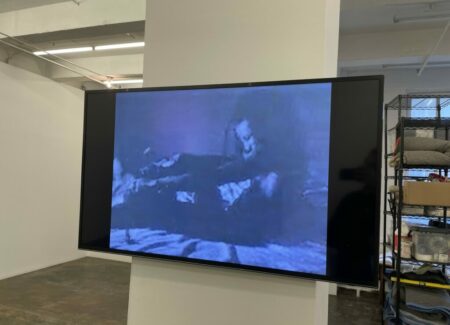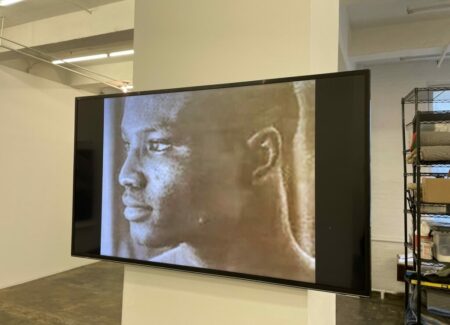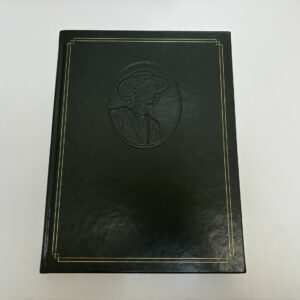JTF (just the facts): A total of 14 black-and-white and color photographs, alternately unframed/framed and hung in the main gallery space. The show includes:
- 6 gelatin silver prints, 1993, sized roughly 73×48 inches (or the reverse), in editions of 6+1AP
- 8 c-prints, 1994, sized 25×25 inches, in editions of 9+1AP
- 1 video, 1994
(Installation shots and video stills below.)
Comments/Context: For many artists with diasporic backgrounds, the feeling of being caught between homelands often runs deep. In the process of searching for and crafting a hybrid identity, each individual with a split history is forced to wrestle with a persistent sense of unease, where one part or another of his or her persona is potentially seen as foreign or “other”, almost regardless of where the person was born or has lived a life.
This show reaches back to the 1990s and the early works in photography and video of the Nigerian-British artist Oladélé Ajiboyé Bamgboyé. Bamgboyé was born in Nigeria, raised in Scotland, and did his undergraduate studies in Glasgow, after his family had returned to Nigeria. In 1992, he went to Nigeria for a visit, reconnecting with parents, siblings, and other relatives he hadn’t seen in more than a decade and rediscovering a Nigerian/Yoruba society he had never known first hand. The works in the show were made in the years after his return to Scotland, when his relationship to the layered complexities of his identity was still very much in flux.
In trying to find a context for Bamgboyé’s works, if we lean on the Nigerian part of his heritage, perhaps we might try to connect him back to a wider lineage of performative African studio portraiture, where aspirational identities were often built from the reflected attributes of fashions, album covers, motorbikes, and other resonant props and poses. But Bamgboyé’s self-portraits seem to cut against this surface styling, paring his self investigations down to elemental nude portraits made in the mundane confines of his apartment. And maybe it is this austere setting which might be tied back to British photography of the 1970s and 1980s, and many of the photographers who were visually redefining what it meant to be British, against the backdrop of economic hardship, unrest, discontent, and increasing multiculturalism. Bamgboyé clearly sits in between these two aesthetic poles, drawing on and blending various influences to create his own self image.
In large scale black-and-white prints from his series “Defining Self Sufficiency” from 1993, Bamgboyé positions his nude body on the floor of the kitchen, on a draped sofa, and in various chairs, posing uneasily in the cramped quarters. Using multiple exposures, he layers versions of his Black body together, creating a shifting multiplied self that refuses to coalesce. His nudity is casual but gracefully blunt, his muscular torso and genitals displayed without self-consciousness, with shadows and ghosted selves adding to a sense of impermanence or ephemerality. He is both there and not there in these pictures, one identity disappearing as another tentatively takes shape, with leftover tools (a hammer and a pair of scissors) perhaps alluding to the active identity construction going on.
Bamgboyé’s 1994 series “Celebrate” exchanges the quiet introspectiveness of his earlier works for a more exuberant mood. In a series of eight color photographs, the artist poses nude with a single wooden chair in a room draped with sheets and colorful metallic streamers. Once again, he employs multiple exposures to break up and recast time, with his blurred body now moving through the space with playful dance-like steps. The scenes bring joy and optimism (perhaps tinged with a hint of hollowness) back into the crafting of a complex diasporic identity, seeming to come from a place of growing self-confidence and acceptance. Another version of Bamgboyé’s ongoing transformation comes forth in a 1994 video titled “The Hair or the Man”, where the shaving off of the artist’s dreadlocks stands as a metaphor for the changes taking place in his identity; as he moves further inward toward himself, the outward appearance of that particular hairstyle is washed away, leaving a smooth clean-shaven head.
While Bamgboyé’s work is likely less well known among the photography community than that of Rotimi Fani-Kayode (another Nigerian-British photographer, albeit of at least a decade earlier), this show is a welcome reminder of his place in the diasporic and post-colonial conversation of the 1980s and 1990s. The gentleness and sensitivity of these self-portrayals masks the more complex grappling with identity that is going on underneath, but their searching contemplativeness feels genuine. These photographs offer no easy answers, just the tangible proof of an artist working through an authentic process of self-discovery.
Collector’s POV: The prints in this show are priced as follows. The large black-and-white prints are $15000 each, while the smaller color prints are $4000 each (or $24000 for the complete set of 8.) Bamgboyé’s work has little secondary market history at this point, so gallery retail likely remains the best option for those collectors interested in following up.
